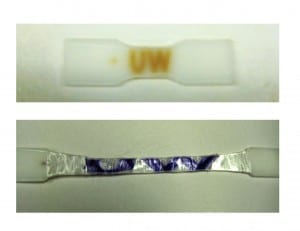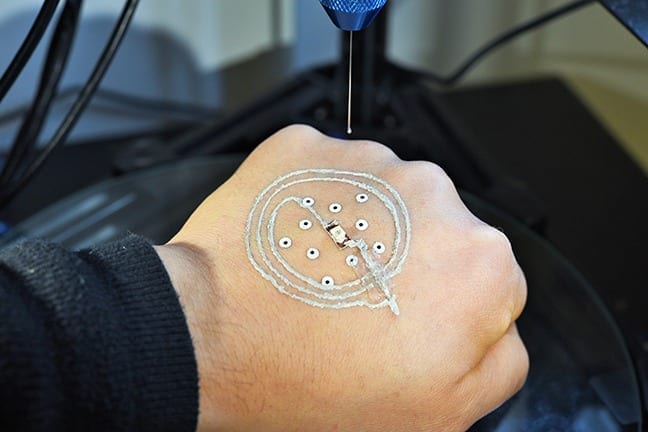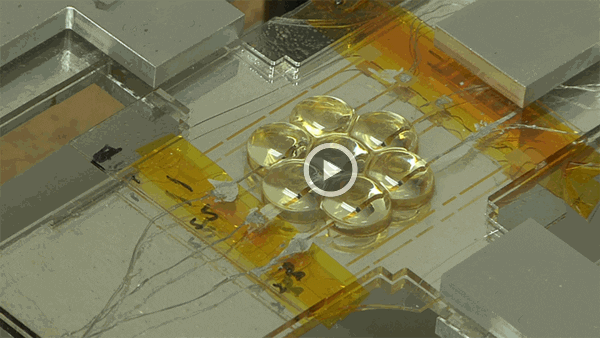
Imagine printing out molecules that can respond to their surroundings.
A research project at the University of Washington merges custom chemistry and 3-D printing. Scientists created a bone-shaped plastic tab that turns purple under stretching, offering an easy way to record the force on an object.
“At the UW, this is a marriage that’s been waiting to happen – 3-D printing from the engineering side, and functional materials from the chemistry side,” said Andrew J. Boydston, a UW assistant professor of chemistry. He is corresponding author on a recent paper in the American Chemical Society’s journal of Applied Materials and Interfaces.
Gregory Peterson and Michael Larsen, UW doctoral students in chemistry, created a polymer, or plastic made up of many repeated units strung together, and fed the soft plastic into the UW chemistry lab’s commercial 3-D printer.
One print head contained polycaprolactone, similar to what a 3-D printer company sells as Flexible Filament. The other print head contained a plastic that is 99.5 percent identical but the UW team made occasional insertions of a molecule, spiropyran, that changes color when it is stretched.
“We wanted to demonstrate that the functional chemistry could be incorporated readily into already printable materials,” Boydston said. “We found that designer chemistry can be incorporated into 3-D printing very rapidly.”
The printed tab is a piece of white plastic with barely visible stripes that turn purple under force. It acts as an inexpensive, mechanical sensor with no electronic parts. The whole device took about 15 minutes to print from materials that cost less than a dollar.
The sensor might be used to record force or strain on a building or other structure. Boydston would like to develop a sensor that also records the speed of the force, or impact, which could allow for a football helmet that changes color when hit with sufficient force.
Read more: 3-D printing with custom molecules creates low-cost mechanical sensor
The Latest on: Designer chemistry
[google_news title=”” keyword=”Designer chemistry” num_posts=”10″ blurb_length=”0″ show_thumb=”left”]
via Google News
The Latest on: Designer chemistry
- Simplicity with simulation: Assisting the battery design industryon April 30, 2024 at 9:02 am
In automotive design, timing is everything. What if simulation could assist the battery design process, saving time and money?
- Quantum challenge to be solved one mile undergroundon April 29, 2024 at 8:32 am
Radiation from space is a challenge for quantum computers as their computation time becomes limited by cosmic rays. Researchers from Chalmers University of Technology, Sweden, and University of ...
- Social Beat bags digital mandate for Juicy Chemistryon April 29, 2024 at 1:12 am
The agency aims to design targeted brand campaigns to boost brand recognition and scale up Juicy Chemistry’s revenue ...
- Making of ‘Lessons in Chemistry' roundtable panelon April 25, 2024 at 8:29 am
You have to take into consideration the storyline as well. Like with Elizabeth Zott, she was definitely not a woman who cared about her looks when we first meet her. And so that was very difficult for ...
- Honor Magic V2 and V2 RSR Porsche Design reviewon April 24, 2024 at 11:44 am
The Magic V2 has a couple of very nice displays that won't leave you wanting in any major way. Both of them are LTPO OLEDs, and they have a 120Hz ...
- Anne Hathaway details ‘gross’ chemistry tests she did in the 2000son April 23, 2024 at 4:17 am
Oscar-winning actress Anne Hathaway has said that she had to kiss a series of actors during the audition process in the 2000s to “test for chemistry” on camera.
- Anne Hathaway on Chemistry With Nicholas Galitzine and Book Easter Eggs in 'The Idea of You' (Exclusive)on April 22, 2024 at 2:39 pm
For Hathaway, she knew that, as a producer of the film adaptation, The Idea of You had to win over both devoted fans of the book as well as newcomers looking to enjoy the unexpected chemistry between ...
- Timberwolves' positive team chemistry cooked up by All-Star Anthony Edwardson April 18, 2024 at 7:23 pm
Whether giving teammates the needle or fessing up to bad plays, Anthony Edwards has the Wolves on a more even keel.
- Dragonfly Mission Takes Next Steps for Final Design, Construction, and Testingon April 18, 2024 at 10:45 am
Does Saturn’s largest moon, Titan, have the necessary ingredients for life as we know it, or even as we don’t know it? This is what NASA’ | Space ...
- ‘More chemistry meetings, please’: Agency new business leaders’ 2024 wish liston April 18, 2024 at 5:09 am
Beyond the dream of standardized RFI questions and credentials, what do new business people in the marketing industry want to see change in the near future? We asked them.
via Bing News










